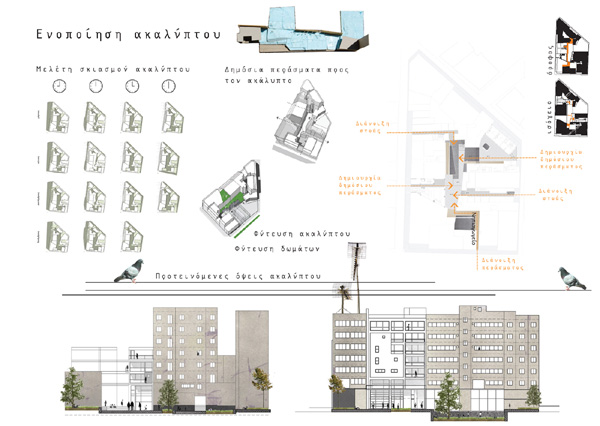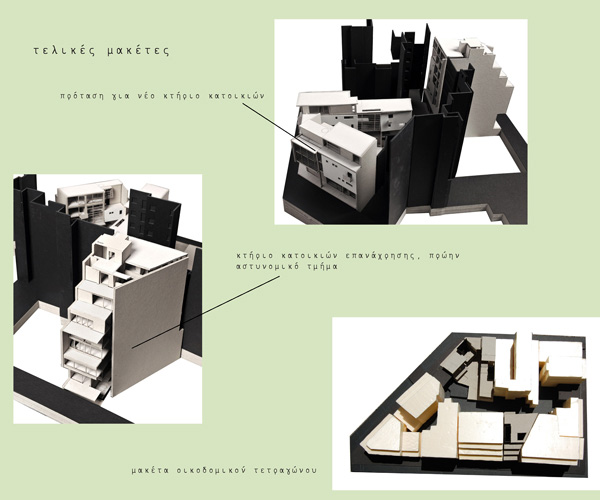STUDENTS PROJECTS
PROJECTS2012
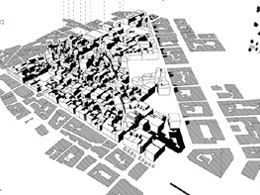
24 March, 2013
2 and 1 cases of rehabilitation of the commercial centre of Athens
Study of a city block.
Students: Voutou Christina, Sereti Maria
Supervisor: Tsiraki Sofia
Co-supervisors: Tournikiotis Panayotis, Moraitis Kostas
NTUA, School of Architecture
Presentation date : March 2012
This diploma project examines the conditions of rehabilitation of the Commercial Centre of Athens. We define three possible ways: the reuse of existing buildings, the creation of new ones and, finally, the renovation of preservable buildings. We choose to focus on a city block (Kolokotroni st., Havriou st., Praksitelous st., Leoharous st.) so as to study the above alltogether. In addition, we unificate and reform the interior courts of the block, and study the opening of the existing galleries, in order to activate the everyday public routes.
The Commercial Centre of Athens
The area constitutes the city' s heart. In terms of urban scale, one can easily remark its division to two sub-districts: the older, and unorderly shaped one, and the newer, hippodameian shaped. Evripidou street functions as a boundary of these two regions
The main use of the area is commerce. From Evripidou st. and up to Omonoia square, however, the main uses are of the third section. All the above day uses do not activate the area from afternoon and on; we spot, however, some new cores of night activities/ entertainment, during the last years (Kolokotroni st., Avramiotou st., Karitsi sq.). It should also be remarked that there is already a housing use in action, in the area, mainly in the retiré s.
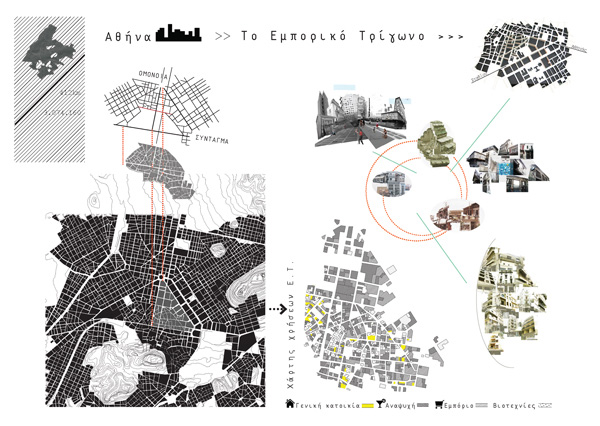
As the rest of Athens city-center, our area as well is highly and densely built. We meet small properties, narrow streets, and a constantly changing ridge. One can discern buildings of all periods of time. The built volumes retreat as we go to the upper levels (the well known "retiré »s, penthouses) and are pierced on the ground floor, creating many public passages, the galleries.
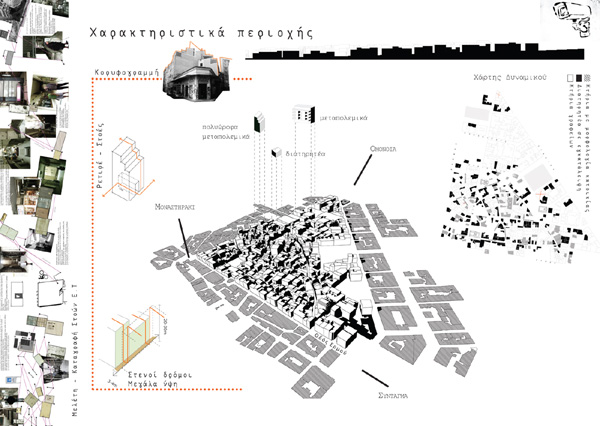
Main criteria for choosing our block:
A large, semi-unified interior court
The existence of buildings capable of reusing
The imminent removal of certain uses (such as the police station)
The proximity to already inhabited spots
The existence of preservable buildings
The proximity to organized parking spaces
The classification of the area's terrains we proceeded in, revealed the oblong terrains as the predominant ones, with their narrowest dimension facing the street. This will be an element to use, for our re-use schedule.
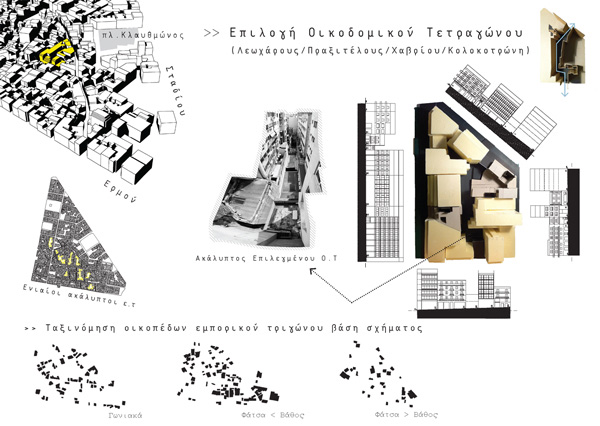
Our primordial concern when designing the housing buildings, was to create some communal spaces inside them. We place these spaces between the domestic areas,, in the new building; in the building to reuse, however, we create for this purpose a multifunctional small theatre, open to the community, on the ground floor. The houses are placed at the best possible orientation, and the all have a terrace in front of the living room
case 01_ Reuse of existent building
If one tried to define some reuse-manuals for the oblong buildings of the Commercial Centre (see above), he would probably come up to the same, recurrent difficulty: a very dark area in the centre of the building, which cannot accommodate any possible use. Our answer to that is... SKYLIGHT !
The 8-floor building on 4, Leoharous str., accommodates the police station of Acropolis. Its construction permit dates back to 1974, which means that the building is designed to receive much greater loads that the ones in action. In the back of ground-floor and mezzanine, there is a 2-storey space -it is there that we place the multifunctional space mentioned. Next to it, we continue the existing gallery to the end of the building, and the interior court.
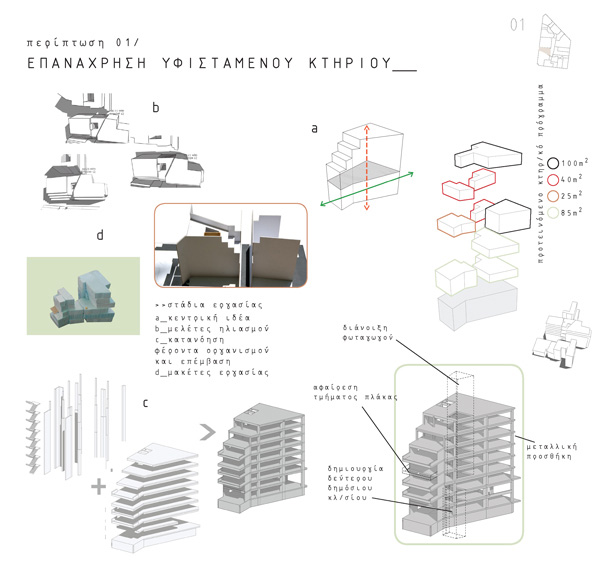
We organize the public functions on ground-floor, mezzanine and first-floor: commerce, office spaces, and the small theatre mentioned. We give the first-floor to office spaces (and not to housing), because of its defective insolation.
Thanks to the central skylight, we create to each next floor two housing units (on on each side of the skylight). We design exceptionally two units on the back of the 3d and 4th level, and one only on the upper retiré.
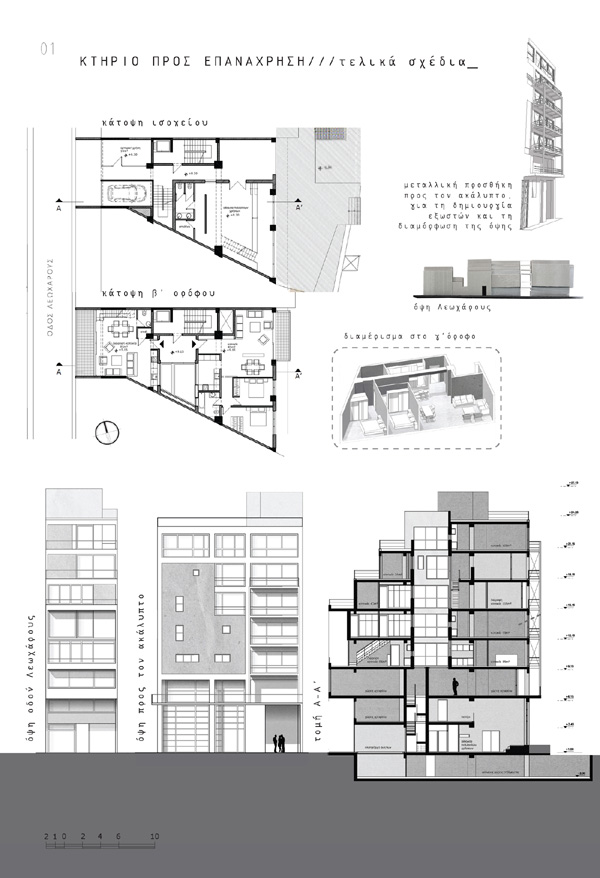
case 02/ New Building in a terrain, hypothetically unbuilt
We choose the site at the corner of Praksitelous st. and Havriou st. (area= 502m2 ) The communal spaces created, are placed between the domestic units, and are sometimes enclosed spaces (for councils or table-tennis games) and sometimes open-air courts. The building also functions as an entry to the block's interior court, through its central, ground-floor yard.
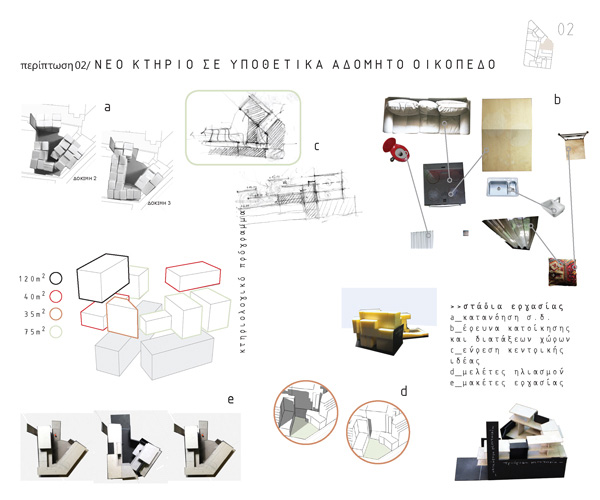
In this case, as well, the public routes are organized at the ground-floor and mezzanine, through commercial uses and the main court of the building, accessible through Havriou str. We place a bookshop-café at the junction of the building with the block's interior court.
The houses are two-storey in general, provided with a two-storey terrace in front of the living-room. They are organized around the two stairwells, outside of which are placed the communal spaces mentioned, as well.
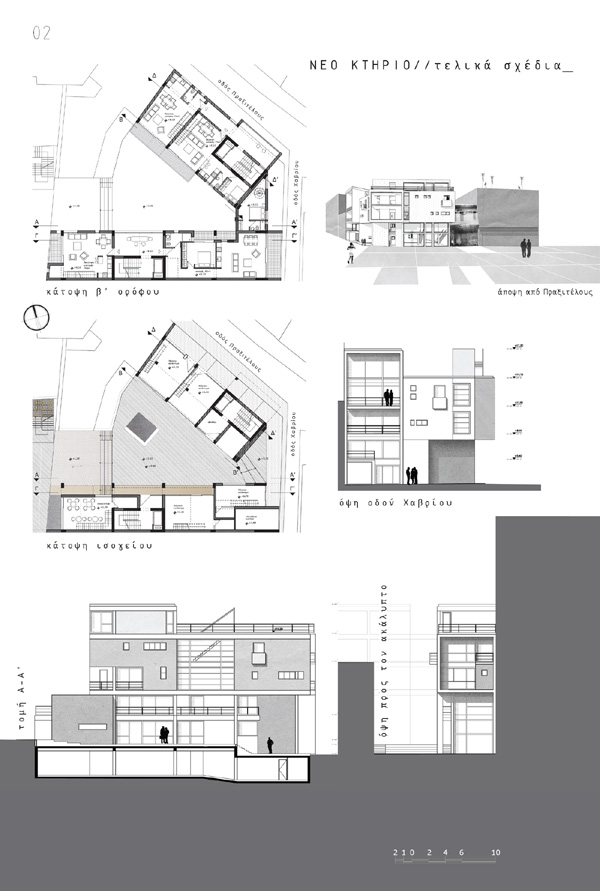
+1/ Some thoughts on preservable buildings
These "open wounds" of Athens' Centre remain mainly un-reclaimed, due to their obscure property conditions and the great costs accompanying their repair. We assume a carrier who will lease and repair them, and propose the installation of uses relevant to housing, such as student restaurants, small-scale student residences, retirement homes, communal places for creative activities, kindergartens, showrooms, libraries, theatres, and Youth Hostels.
On the building in 32, Kolokotroni st. (ownership of Panagia of Tinos), specifically, we design the reform of its back yard to a small-scale playground, accessible through the street. This passage will be the one of the five in total passages to the block's interior court.
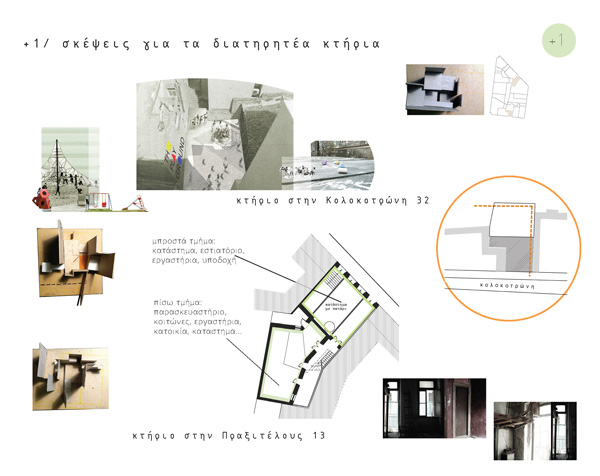
The creation of a unified, communal block's interior court
We define the following scenario concerning the functioning and planting of the communal, open-air spaces of the block:
A) on the street-level (+0,00): linear planting/ public
B) on the interior court's level (+3,00): wild and dense planting/ communal
C) on the roofs' level (variable): light creeping plants/ communal for each block of flats
